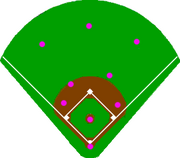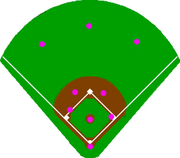Baseball positioning
This articleneeds additional citations forverification.(September 2009) |

Inbaseballandsoftball,while there are nine namedfielding positions,players, with the exception of thepitcherandcatcher,may move around freely. Thepositioningfor the other seven positions is very flexible, although they all have regulardepths—distances fromhome plate,and sometimes lateral positioning. Ashiftmeans that a player is playing in a noticeably different location than the norm for his positioning. A fielder who is playingshalloworinis playing closer to home plate, while a player playingdeepis playing farther from home plate than normal.
Common types of positioning[edit]
Regular terms are used for some positionings. For example,double play depthis used when there is potential for aforce playatsecond base.This means theshortstopandsecond basemanare playing slightly closer to second base and sometimes a little bit shallower. This position makes it easier to turn thedouble play.
Thefirst basemanis said to beholding the runnerif he positions himself right at first base with one foot on the base, ready to receive apickoffthrow from the pitcher if the runner strays too far from first base between pitches.
Bringing the corners inmeans the first and third baseman are both playingin(closer than usual to home plate); this will often be used with runners at third base or when abuntis anticipated.
The disadvantage of these defensive shifts is that they make more room for the hitter to hit the ball through the gaps for a base hit or lay down a successful bunt too far from any fielder to make a play resulting in an out.
Sometimes in the bottom half of the ninth inning (or later), when a team has a runner on third base in a tie game with less than two outs, the defending team will pull the outfielders in very close, almost creating three extra infielders. This is sometimes known asdo or diedepth. The reason for positioning this way in this situation is that there is no point in having the outfielders playing deep, waiting to catch a fly ball for an out; if they do, the runner at third base will be able totag upwhen the ball is caught and then run to home plate to score the winning run. So the outfielders can contribute constructively only by filling the gaps between the infielders.
Infield shift[edit]
Some extreme repositioning known as ashiftwas used againstpull hitters,a strategy that became more prevalent in Major League Baseball since the late-2000s.[1]For example, versus excellent left-handed pull-hitters likeTed Williams,David Ortiz,Joey GalloandRyan Howard,teams would move more players to the right side of the field. They would sometimes play with the shortstop behind or even to the right of second base. The second baseman may simply move to the right, in which case this just qualifies as a shift, or he might move deeper into shallowright field.Another variation had the third baseman move to where the shortstop would play in the shift, leaving the shortstop (who is generally the team's best infielder) to cover the left side of the infield.
Many believe that this shift was first employed against Ted Williams in the 1940s, as thought up by then-IndiansmanagerLou Boudreau.However, it was first used againstCy Williamsin the 1920s.[2][3]
The infield shift was restricted by MLB beginning in the2023 season.
See also[edit]
References[edit]
- ^"9 things you need to know about the shift".MLB.Retrieved2018-11-28.
- ^Vass, George (August 1999).20th Century All-Overlooked Stars.Retrieved27 May2012.
{{cite book}}:|work=ignored (help)[permanent dead link] - ^Vass, George (July 2004).Baseball's Forgotten Stars.Retrieved27 May2012.
{{cite book}}:|work=ignored (help)[permanent dead link]





